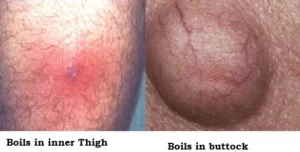What is BOILS

Boils are localized infections which occur in hair follicles or oil glands. They typically appear as red, swollen, and painful lumps filled with pus.Boils are usually caused by bacteria, most commonly Staphylococcus aureus, which enters the skin through a cut or other type of break.
The immune system responds to the infection by sending white blood cells to the area, leading to the formation of pus and the characteristic boil.it can develop anywhere on the body but are most commonly found on areas that are prone to friction, pressure, or sweat buildup, such as the face, neck, armpits, buttocks, and thighs. They can range in size from small, pea-sized bumps to larger, golf ball-sized lesions.
Treatment for boils: often involves home care measures, such as applying warm compresses to the area several times a day.
This can help promote the drainage of the boil and relieve pain.It’s important to avoid squeezing or puncturing the boil , as it can lead to further infection or the spread of bacteria.
If a boil is particularly large, painful, or persistent, medical attention may be necessary.
A healthcare professional may choose to drain the boil by making a small incision and allowing the pus to drain out. They may also prescribe antibiotics if the infection is severe or has spread.
To prevent, it’s important to maintain good hygiene, keep the skin clean, and avoid sharing personal items with others.
If you have recurrent boils, it’s best to consult a healthcare professional for an accurate diagnosis and appropriate treatment.
HEAT BOILS
Heat boils, also known as heat abscesses or furuncles, are a type of skin infection that occurs when bacteria enter a hair follicle or sweat gland. Staphylococcus aureus bacteria is the causes.
Heat boils are more likely to develop in areas where sweat accumulates and friction occurs, such as the armpits, groin, buttocks, and thighs.
The primary symptom of a heat boil is a painful, red, and swollen lump on the skin.
Over time, the lump fills with pus, and it may eventually rupture, allowing the pus to drain. Heat boils is quite tender . It causes discomfort when touched or when pressure is applied.
Treatment.
It is recommended to apply warm compresses to the affected area several times a day. The warmth helps to increase blood circulation to the boil, which aids in healing and promotes the natural drainage of pus.
It’s important to avoid squeezing or attempting to lance the boil yourself, as this can lead to further infection or scarring.
If the heat boil is large, persistent, or accompanied by severe symptoms such as fever or spreading redness, it is advisable to seek medical attention.
A healthcare professional may choose to drain the boil using a sterile needle or make a small incision to allow the pus to drain completely.
They may also prescribe antibiotics if the infection is severe or if you have a compromised immune system.
Preventing heat boils involves maintaining good hygiene, keeping the skin clean and dry, wearing loose-fitting clothing, and avoiding excessive sweating.
Regularly washing the affected areas with antibacterial soap can also help prevent bacterial colonization.
For recurrent heat boils, it is best to consult a healthcare professional for an accurate diagnosis and appropriate treatment.
WHAT ARE THE OTHER NAMES OF BOILS?
Boils can be call as:
1.Furuncles: Describe boils that occur in hair follicles.
2.Abscesses: Boils referred to as abscesses, especially when they are larger and filled with pus.
3.Carbuncles: A carbuncle is a cluster of interconnected boils that usually occurs deeper in the skin. It is often larger and more severe than a single boil.
4.Skin abscess: This describes a localized collection of pus within the skin.
5.Staph infections: Boils are caused by a type of bacteria called Staphylococcus aureus, which called staph infections.
Kindly note that all these terms are related to boils but may have slightly different clinical definitions and implications, therefore Consulting a healthcare professional can provide accurate diagnosis and appropriate treatment for specific skin conditions.
WHAT YOUR BODY LACKING WHEN YOU GET BOILS
When a person develops boils then it can sometimes indicate an underlying issue or deficiency in the body. Here are a few potential factors that may contribute to these developments:
1.Weakened Immune System: A weakened immune system can make the body more susceptible to infections, Factors that can weaken the immune system include chronic illnesses, certain medications, poor nutrition, and stress.
2.Poor Hygiene: Inadequate hygiene practices, such as infrequent washing or not properly cleaning the skin, can increase the risk of bacterial infections and the development of boils.
3.Staphylococcus aureus Bacteria: Boils caused by Staphylococcus aureus bacteria that can found on the skin and may enter the body through cuts, breaks, or hair follicles, leading to infection and boil formation.
4.Diabetes: Individuals with diabetes more prone to developing boils due to impaired immune function and elevated blood sugar levels, which can promote bacterial growth.
5.Nutritional Deficiencies: Nutritional deficiencies in vitamins A, C, and E, zinc, or iron, can impact the immune system’s ability to fight off infections effectively. Inadequate nutrition can weaken the body’s defenses and contribute to the occurrence.
It’s important to note that these factors are not definitive causes for every individual case.
To buy related products for treatment on Amazone Pl click below:
Permalink: https://sypta.com/ BOILS-HOME REMEDIES /
#whatyourbodylackingwhenyougetboils, #boils, #heatboils

[…] Permalink: https://sypta.com/boils-heat-boils-cause-of-boils/ […]
Everything is very open with a clear clarification of the issues. It was definitely informative. Your site is extremely helpful. Thanks for sharing!
Thank you